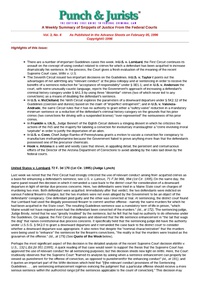Here the Court held that the district court did not abuse its discretion in denying a motion to sever, since the conflicts between the two defendants were "minor" - and did not significantly prejudice the movant.
Although the Court acknowledged that there were some "minor conflicts" between two defendants' defenses, …
Here the Court held that the Government failed to provide sufficient evidence that the defendant had distributed drugs within a school zone, when its evidence was only that the distance between his "address" and the school was 920.2 feet.
In this case the Court observed: "The police testified that in …
Case held that expert testimony indicating an intent to distribute was not improper opinion testimony on the ultimate issue; and in the process gave a detailed explanation of the history and purpose of Rule 704(b).
In this drug case, the defendant did not dispute his possession of crack cocaine, but …
In this case Judge Scheindlin refused to impose a two-level "sophisticated means" enhancement to a sentence under § 2T1.1(b)(2), as recommended by the Government. In one of her typically detailed and well-reasoned analyses, she started by noting that "it is not easy to define the term 'sophisticated means'." Her decision, …
Here the Court called into question the constitutional implications of the district court's use of two murders for which the defendant had been acquitted to enhance his sentence based on a finding that the murders had more than likely been committed.
In U.S. v. Lanoue, 71 F.3d 966, 984 (1st …
This case discusses the concept of "imperfect entrapment" (i.e., aggressive encouragement of a crime that does not rise to the level of entrapment), and whether such aggressive encouragement of wrongdoing may be used as a basis for a downward departure under U.S.S.G. § 5K2.12 (coercion and duress). The defendant made …
This is another important Guidelines case from the 7th Circuit, this one dealing with U.S.S.G. § 4A1.3 (adequacy of criminal history category). Here, the defendant pled guilty to conspiracy to possess cocaine with intent to distribute it. Relying on § 4A1.3 (a policy statement), the lower court increased the defendant's …
This is another case that shows how rigid laws and sentencing by the numbers have become more important than justice and judicial discretion. The defendant pled guilty to possession of some methamphetamine with intent to distribute, which by law requires a mandatory minimum sentence of 10 years. In 1994, Congress …
Of the many issues explored in this case, one deals with the concept of "acceptance of responsibility" and it is a forceful reminder of the advantages of silence at sentencing. Prior to Nov. 1, 1992, a defendant could obtain a sentence reduction under § 3E1 of the Guidelines only if …
This case involves an appeal by a court-appointed criminal defense attorney who was convicted of criminal contempt of court for willfully disobeying or resisting a lawful order of a court. In the process, the decision reviews Rule 42(a)'s summary contempt procedures and Rule 42(b)'s notice and hearing procedures; it also …
In this case the defendant entered into a "wired" plea agreement, under which the defendant and his two co-defendants were told that none of them would receive the benefits of the Government's plea offer unless all three of them agreed to plead guilty. At the time the plea was entered, …
